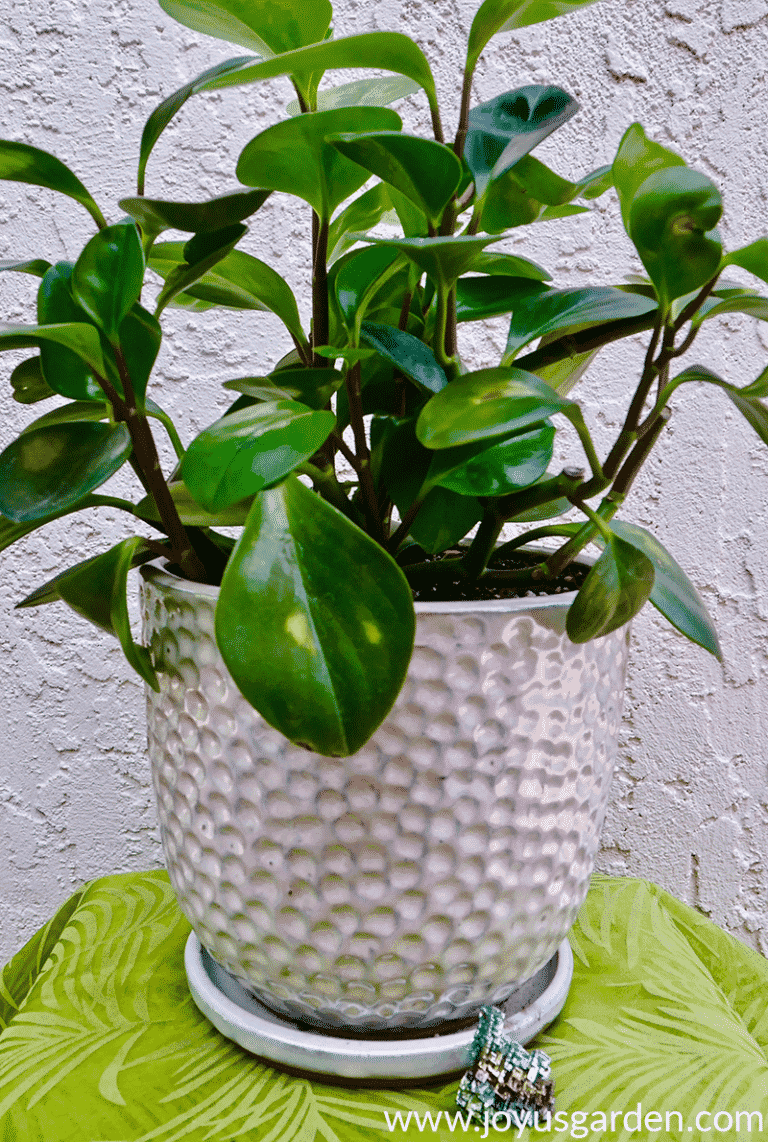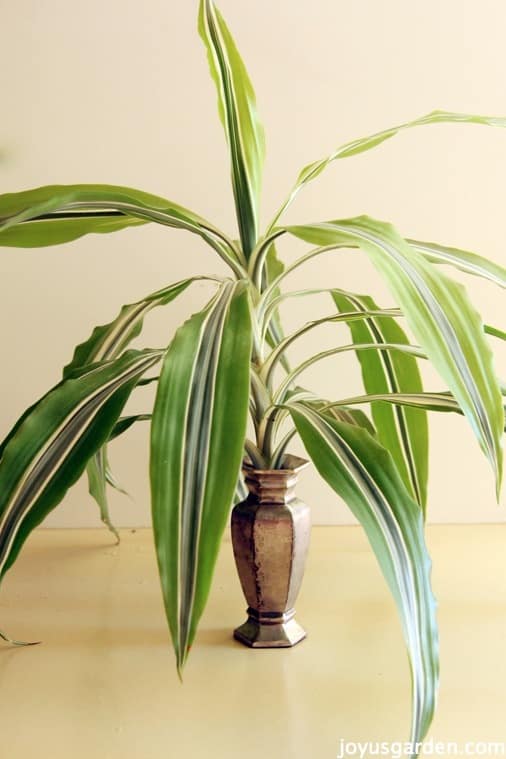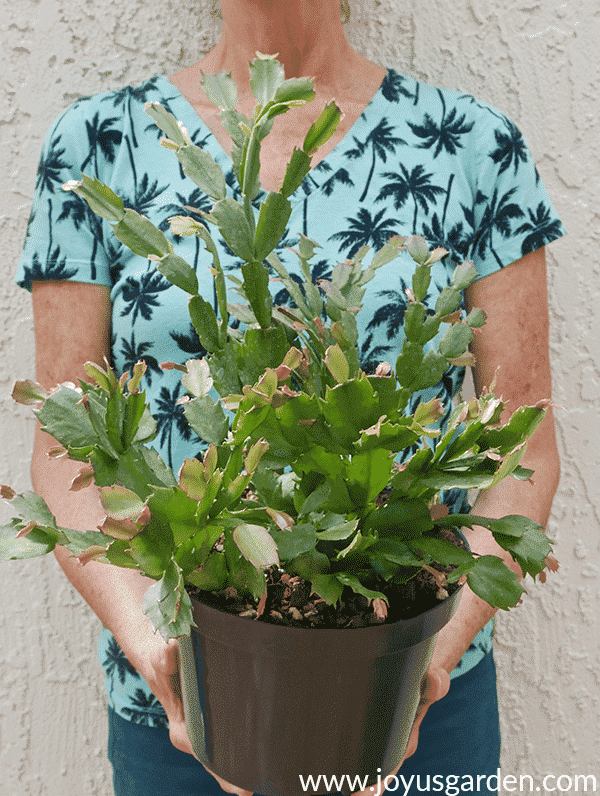Marble Queen Pothos Care: A Growing Tips Guide
You’re probably familiar with the widely known pothos plant, but did you know there are many varieties? The Marble Pothos stands out with its white and cream variegated heart-shaped leaves, setting it apart from the solid green Pothos or the very popular Golden Pothos. While Marble Queen Pothos care is similar to most other Pothos varieties, its exposure requirements differ; more below.
Managing Pothos plants is generally hassle-free. Over time, I’ve amassed a collection, and they’ve thrived in my various homes across different climate zones. These plants are undemanding and resilient, requiring minimal attention, making them an excellent choice for those venturing into indoor gardening.
Here’s a quick guide to Marble Queen Pothos plant care, covering light needs, watering, propagation techniques, soil preferences, and more. Let’s delve into the details and explore how simple it is to grow a Marble Pothos!
Botanic name: Epipremnum aureum ‘Marble Queen’ Common name: Marble Queen, Devil’s Ivy
Marble Queen Pothos Plant Traits
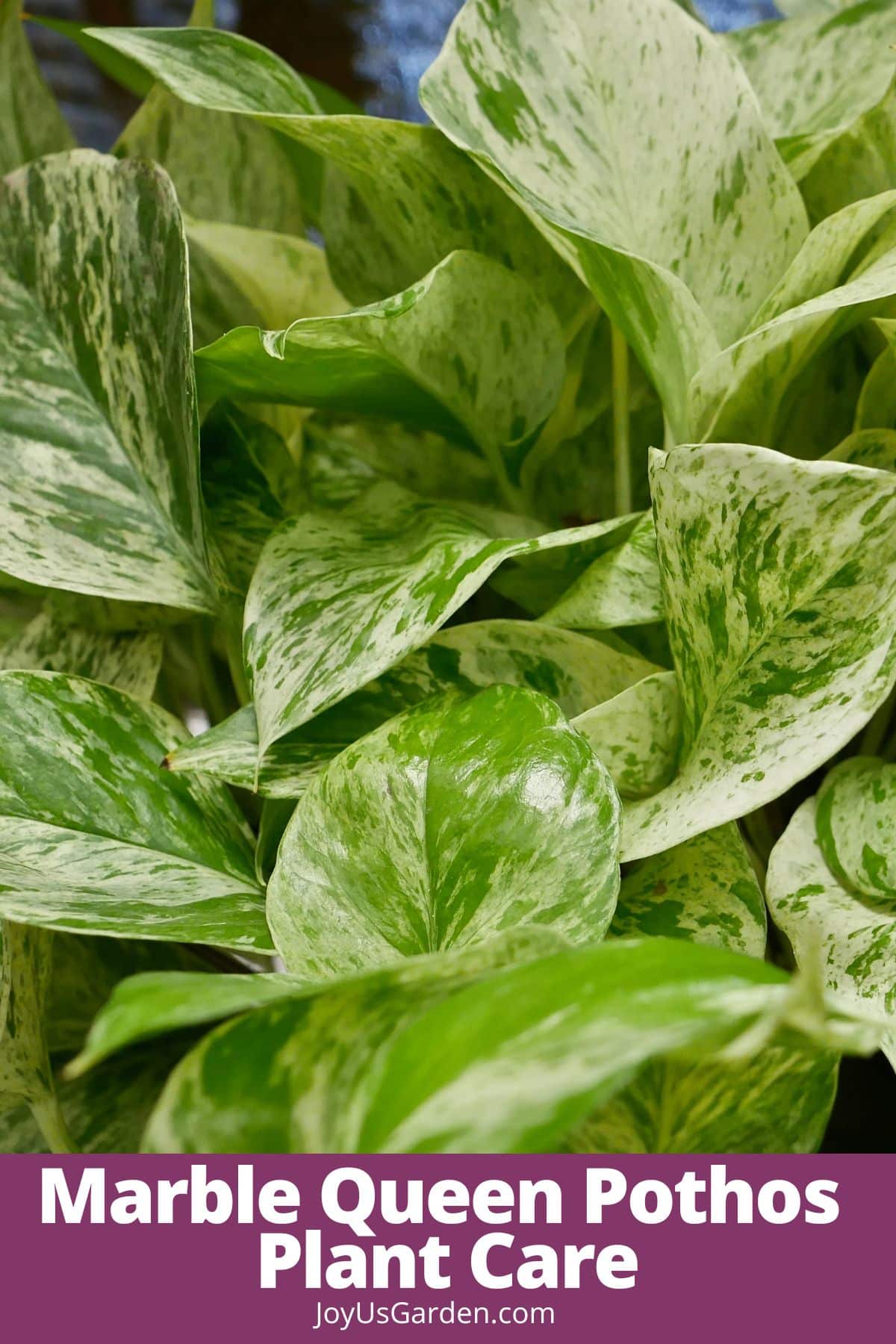
How to Use Marble Pothos
Marble Pothos are trailing plants and great to use in a hanging container. This plant loves to have its trails dangling, so don’t be afraid to hang your Marble Pothos or place it on top of a bookshelf if you’d like it to trail down gracefully.
I’ve seen Pothos trained to grow upwards, cascading over hoops, on tall pieces of wood or bark, adorning trellises, wrapping around moss poles, clinging to walls via clips, and enhancing dish gardens and living walls.
Size
They are typically sold in nurseries and big box stores ranging in pot size from 4″ to 10″; the 6″ to 10″ pots often have attached hangers, which are easily removable if desired.
When grown indoors, they typically reach 8′ to 10′ in length.
Growth Rate
The majority of pothos varieties have a moderate to fast growth rate, especially in warmer temperatures. In winter, the growth of many houseplants tends to slow down, and it’s common not to get substantial growth during the cooler months.
Pothos in low-light conditions will have a slower growth rate. If you have the space to provide higher light, take advantage of the opportunity to promote faster growth, increased fullness, and enhanced variegation.
Pothos Varieties
Numerous types of Pothos varieties are available, including Golden Pothos, Pothos N Joy, Jade Pothos, Neon Pothos, Pothos Pearls and Jade, Glacier Pothos, Snow Queen Pothos, Jessenia Pothos, Blue Pothos, and Silver or Satin Pothos. It’s worth noting that the Silver or Satin Pothos, although belonging to a different genus, is often grouped with the other pothos because of its common name.
These pothos plants are cultivated by growers across various regions, primarily in Florida, California, Texas, and Hawaii.
Marble Queen Pothos Plant Care And Growing Guide
Marble Pothos Light Requirements
With their heavily variegated leaves, Marble Queen Pothos plants require brighter light than solid green Pothos to maintain that variegation. Your Marble Pothos should be grown in medium to high bright light, with moderate or bright indirect light ideal.
When growing in high light, maintain a distance of 5′ or more from a west or south-facing window to prevent potential burning from direct, intense sunlight. If your plant grows up against hot glass, it’ll burn in no time.
In low-light settings, these plants grow at a slower pace, and exhibit a leggy, sparse appearance and smaller leaves. Variegated types like Marble Pothos will lose their variegation and revert to solid green leaves if they don’t get enough light. Many show a mix of green and variegated leaves, depending on the exposure.
Periodically rotate the plant when the leaves are leaning towards the light source. If light levels significantly decrease in winter, consider relocating the plant to an area with more light. Get additional tips on winter houseplant care here.
I’ve done a post & video answering your FAQs About Pothos Plants that you’ll find helpful.
Marble Queen Pothos Watering
Water your Marble Pothos plant when the soil is on the verge of drying out. Maintaining the soil on the slightly drier side, instead of consistently wet, will help prevent root rot.
Living in the warm and sunny environment of Tucson, AZ, here in the desert, I typically water mine every 6-7 days in the warmer months and less frequently, around every 9-14 days, during the winter.
Providing an exact watering schedule for you is challenging due to varying factors such as the plant’s location, home environment, soil mix, time of year, and pot size.
It’s best to have drainage holes at the bottom of the pot to let excess water flow out freely. You’ll want to prevent the accumulation of too much water in the saucer if one is placed beneath the pot.
During winter, a Marble Pothos requires less water and benefits from a break in fertilizing and pruning.
I’ve written a guide to Watering Indoor Plants that you may find helpful.
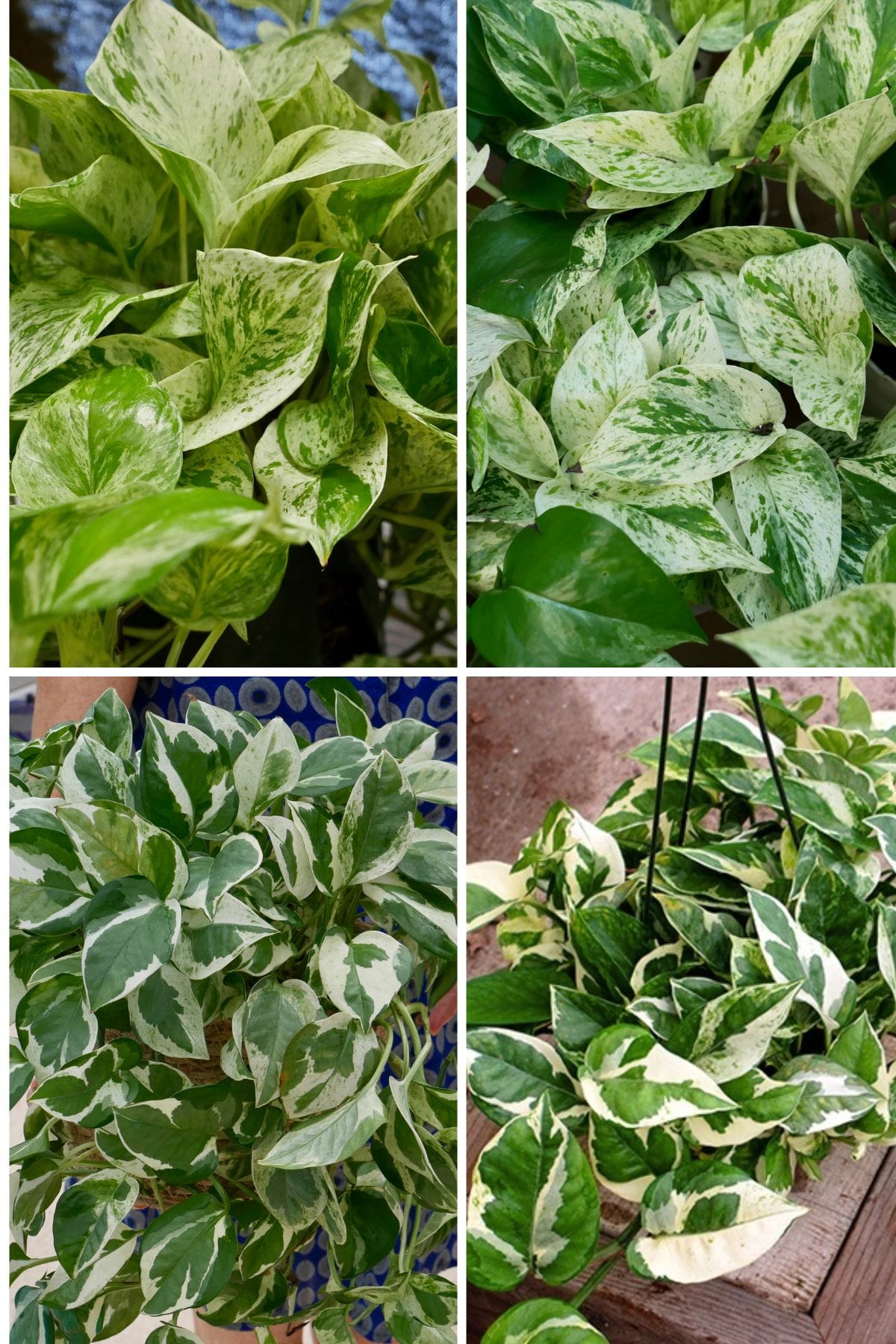
Temperature
Maintaining the right temperature for Marble Pothos care isn’t complicated. They have a broad temperature tolerance, and if your home is comfortable for you, it’ll be comfortable for your Marble Pothos and other houseplants.
It’s best to avoid placing them near cold drafts or in proximity to heating or air conditioning vents.
Humidity
Marble Pothos is a tropical plant and is accustomed to high humidity; however, they seem to thrive in our homes’ lower humidity levels.
If you notice occasional brown tips on the leaves, it’s likely a response to the dry air. Mine has some tiny brown tips, but you need to get close to see them.
For those seeking to increase humidity in their homes, here’s a suggestion:
I have a humidity meter in my dining room that is both inexpensive and effective, still working fine after a few years. I use Canopy humidifiers at night when the humidity readings are low, which is especially welcome in the dry climate of the Arizona desert!
Misting the leaves a couple of times a week or adding a pebble tray can also be beneficial. I’ve used driew Plant Mister Spray Bottle for a few years, and it’s still going strong.
Marble Pothos Fertilizing
The ideal time for fertilizing your plants is during spring and summer, with the possibility of extending into early fall if you reside in a temperate climate.
In Tucson, we enjoy a long growing season from mid-February through October. I feed my plants seven to eight times (once per month) during the growing season. This is the routine for all my tropical plants.
I currently use Maxsea or Sea Grow, and Grow Big to feed my plants. I alternate using these fertilizers individually without mixing them.
Depending on your climate, growing zone, and what fertilizer you use, providing nutrients two or three times a year may be sufficient for your indoor plants.
Marble Queen Pothos plant care doesn’t demand much attention regarding fertilizing. You want to avoid over-fertilizing, which can be more harmful than beneficial.
Regardless of the chosen houseplant food, it’s essential not to exceed the recommended amount or frequency, as the accumulation of salts can lead to root burns. Signs of overfertilization often manifest as brown spots or large brown tips on the leaves.
Refrain from fertilizing in late fall and winter, as these are not active growing seasons for houseplants. Additionally, it’s best to avoid fertilizing stressed houseplants, whether bone dry or excessively wet, to ensure their well-being during reduced activity or stress periods.
Soil For Marble Pothos
For my Marble Pothos, I always use good quality potting soil formulated for houseplants, which is peat-based, well-nourished, aerated, and has good drainage.
These are the potting soils I alternate between using: Ocean Forest and Happy Frog. I also add a few amendments to the potting mix when planting. You can read more about my soil blend by clicking the link in the “Repotting” section below.
Repotting/Transplanting
Spring and summer are the optimal seasons for repotting your Marble Pothos, while those in warmer climates can continue into early fall.
When repotting, I typically transition to a larger pot size, such as upgrading from a 4″ to a 6″ pot. If your 6″ Marble Pothos is large and tightly packed, you might consider repotting it into a 10″ pot, ensuring that the pot size aligns with the plant’s dimensions and rootball size.
A couple of clear indications that it’s time for repotting is when roots emerge from the bottom of the pot or the soil looks depleted. Generally, I repot my Pothos plants every five years, allowing the roots more space to grow and refreshing the soil.
For Marble Pothos with longer trails, there’s potential for tangling when repotting. I loosely tie the trails together to keep them manageable and out of the way during repotting. I liken it to tying a very long ponytail!
As for the type of pot, the material doesn’t significantly impact the plant’s well-being. I’ve successfully grown pothos in plastic, terra cotta, fiberglass, resin, and ceramic pots—all serving the plant equally well.
Your pot should have at least one drainage hole at the bottom to prevent excess water from building up and causing root rot.
This post on Pothos Repotting details how to repot pothos plus the soil mix to use.
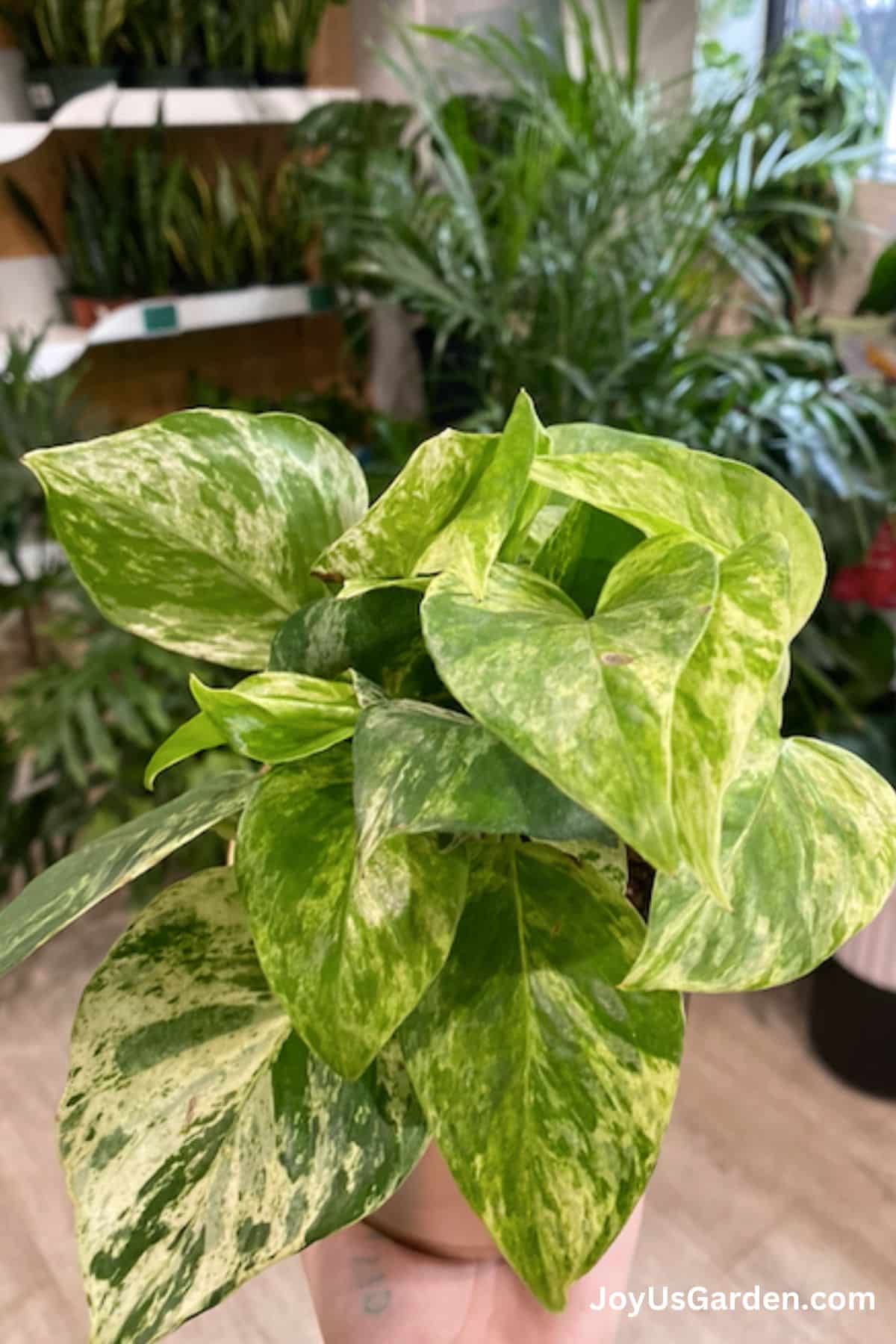
Marble Pothos Pruning
Pruning plays an important role in Marble Queen Pothos plant care.
You can prune your pothos to manage the length by making a straight cut across the stem just below a node. This controls the length and stimulates new growth at the top.
Similar effects can be achieved by pinching or tip pruning the trails (1-4 nodes back at the ends of the trails). This will help restore your Pothos’ fullness if it has gotten leggy.
Trails with leafless sections can be trimmed off and propagated, as leaves won’t regrow on those bare parts of the stems.
Just like fertilizing and repotting, it’s best to do pruning during the spring and summer months.
Propagating Marble Pothos
Marble Pothos propagation is uncomplicated, particularly when using the stem cuttings in water method. I’ve found this to be the easiest and best way to propagate pothos. By doing this, I can see the rooting action!
The stems naturally develop aerial roots from the nodes (they’re dried-looking brown nubs that appear at the leaf nodes), making the propagation process a breeze.
Once you’ve taken the cuttings, start the process by removing an adequate number of leaves from the stems (usually 1-4, depending on the cutting’s length). Fill your glass or jar with enough water to cover one to two nodes, ensuring that any foliage remains above the water level.
Maintain the water at this level, replenishing it as necessary. Typically, roots will begin to emerge within seven to ten days.
I’ve kept Marble Pothos stem cuttings in water for eight months, and they’ve remained healthy.
You can also propagate pothos by stem cuttings in soil mix or by division.
This post and video on Pothos Propagation will give you more details on propagating and pruning.
Pests
While living in Santa Barbara, one of my pothos faced a mealybug infestation, which I promptly identified and addressed. Here’s how to get rid of mealybugs on plants.
While working as an interior landscaper, I encountered pothos plants plagued by spider mites and scale.
Given that pests often migrate from one houseplant to another, taking swift action upon detecting plant pests is crucial.
Neem oil or insecticidal soap is effective for managing most pest infestations. I’ve been using insecticidal soap for two years, and it has proven to be quite effective.
Yellow Leaves On Marble Pothos Plants
Encountering the occasional yellow leaf is a normal part of a plant’s growth cycle, and I regularly prune or pinch off one or two yellow leaves from my pothos every few months.
However, an excess of yellow leaves indicates an underlying issue. Multiple factors, including overwatering, underwatering, excessive fertilizer, inadequate or excessive light exposure, pest infestation, and poor soil drainage, could contribute to this problem, with overwatering being a particularly prevalent cause. Pothos don’t like to have wet soil 24/7!
You can trim away any yellow leaves to maintain the plant’s aesthetic.
Toxic To Cats & Dogs
Pothos plants are recognized as toxic to pets. To gather information on the specific nature of the toxicity, I refer to the ASPCA website.
For pet owners whose animals tend to chew on plants, I recommend either elevating the pothos or hanging them out of reach. This makes it difficult for pets to access the plants and helps prevent the risk of potential harm.
Here’s a list of 11 Pet-Friendly Houseplants for your reference.
Conclusion: Marble Queen Pothos care is exceptionally simple, and their lengthy and plentiful trails add to their appeal. These houseplants are low-maintenance and versatile. Plus, their lively and vibrant foliage brightens up any room!
Happy Gardening,


